Idli Sambar is a traditional South Indian breakfast featuring soft, steamed rice-lentil cakes (Idli) paired with a fragrant and spiced lentil-based vegetable stew (sambar), prepared with tamarind, lentils, and a unique blend of spices. Also known as Tiffin Sambar, it is served with Coconut Chutney for a complete tiffin meal. This hotel-style recipe offers a hearty, vegan meal of fluffy idli with savory, lightly tangy sambar made from lentils and vegetables — a winning combination!
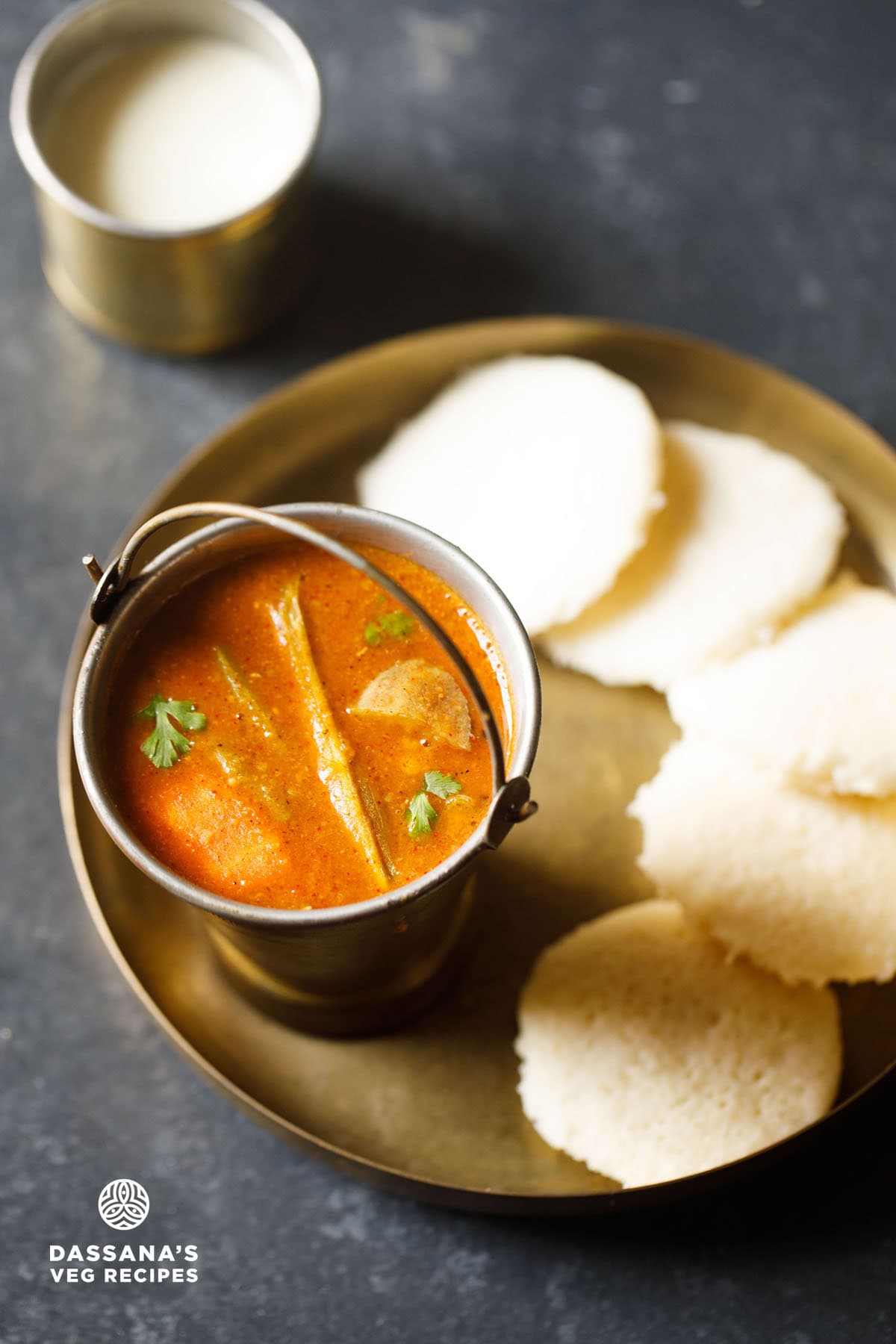
About Idli Sambar Recipe
If there’s one comforting dish in South Indian cuisine, it’s Idli Sambar — a tasty, hotel-style Tiffin Sambar served with soft, fluffy idli.
The hallmark of this recipe is the addition of freshly roasted and ground spices. Tomatoes are also a key ingredient in this recipe that impart a lovely taste in the sambar.
In South Indian cuisine, there are many ways the traditional Sambar is made. This Tiffin Sambar is one such variation which gives you a flavorful sambar like the one served in South Indian restaurants and hotels.
Apart from idli, this sambar can also be served with other South Indian tiffin snacks like Dosa, Medu Vada, Uttapam and even Pongal.
Table of Contents
The preparation of this Idli Sambar recipe is a bit time-consuming as it has many elements to be done. But, if you follow the recipe well, you should not have any problem in making it.
In this recipe, I have also shared the way of making a fresh sambar powder that just elevates the flavors of this dish.
For the sambar powder of this Tiffin Sambar, you would need dried red chilies, curry leaves, coriander seeds, split and husked Bengal gram (chana dal), cumin seeds, mustard seeds, whole black peppercorns and fenugreek seeds. You can use any neutral flavored oil to roast these ingredients.
Besides this, there are the usual elements in this recipe of Idli Sambar too. Like the tamarind pulp, a mix of vegetables, cooking the lentils and then cooking everything together that results in a wholesome sambar variation.
This is also one of the best Tiffin Sambar recipe. This hotel style sambar tastes really heavenly with cushiony soft, fluffy idli. Oh yes, Idli Sambar and vada sambar are an all-time favorite at home too. Not to forget, our love for dosa too.
This recipe of Tiffin Sambar was shared by a reader who writes to me often. She was gracious enough to share her sambar recipe as well as this particular recipe.
The recipe is also adapted from Revathy Shanmugam’s recipe and the reader was kind enough to translate and share it with me.
I had the good chance of having a fruitful email conversation with Revathy ji who is a gracious and humble person, through another common friend.
I made some changes in this Idli Sambar recipe to suit our taste buds. This dish was loved by the family and so they would ask me to make it again and again.
Even today, I make this sambar and team it up with idli or medu vada. You can also enjoy this with steamed rice for a comforting meal.
To make idli, you can check my fail-proof recipes of the traditional Idli Recipe and Rava Idli (a quick and easy idli variety made with suji or semolina).
While serving this dish, you can even drizzle a bit of ghee on top. You can also top it with some chopped onions or garnish with some coriander leaves.
How to make Idli Sambar
Cook Lentils
1. In a bowl, take ¼ cup each of tur dal/arhar dal (pigeon pea lentils) and masoor dal (red lentils). You can also just use a total of ½ cup tur dal.
As you see in the picture below, pigeon pea lentils are yellow colored and they are split and without husk. The red lentils or orange colored lentils are also husked and split.
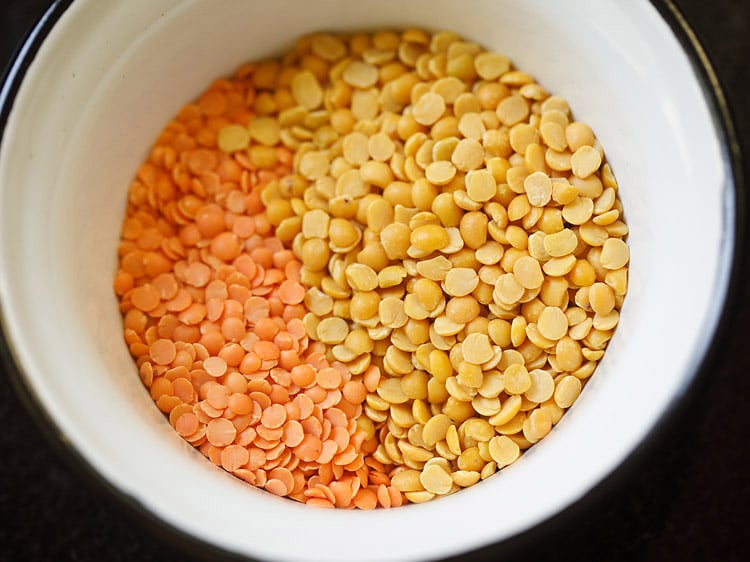
2. Rinse the lentils well in fresh water and add in a 2-liter stovetop pressure cooker.
You can also cook these lentils on a stovetop pan or Instant Pot. If cooking in a pan, I suggest to soak the lentils in enough water for at least half an hour, so that they cook faster.
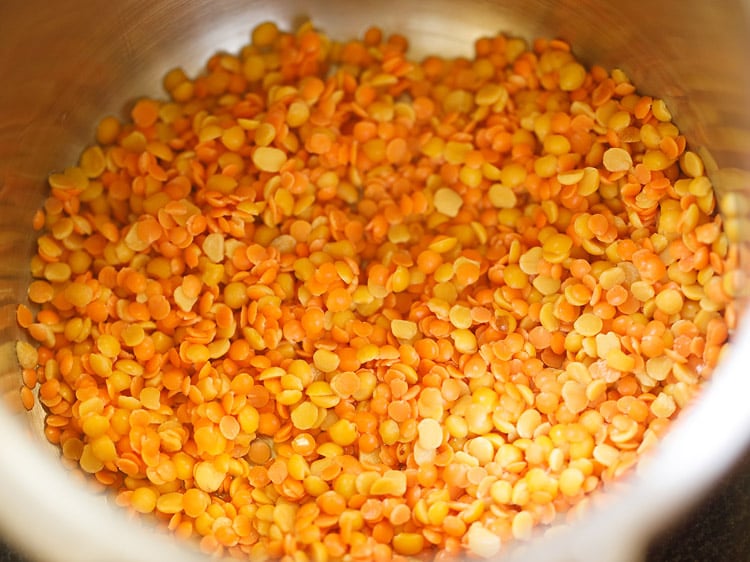
3. Add ¼ teaspoon turmeric powder and 1.25 to 1.5 cups water in the pressure cooker.
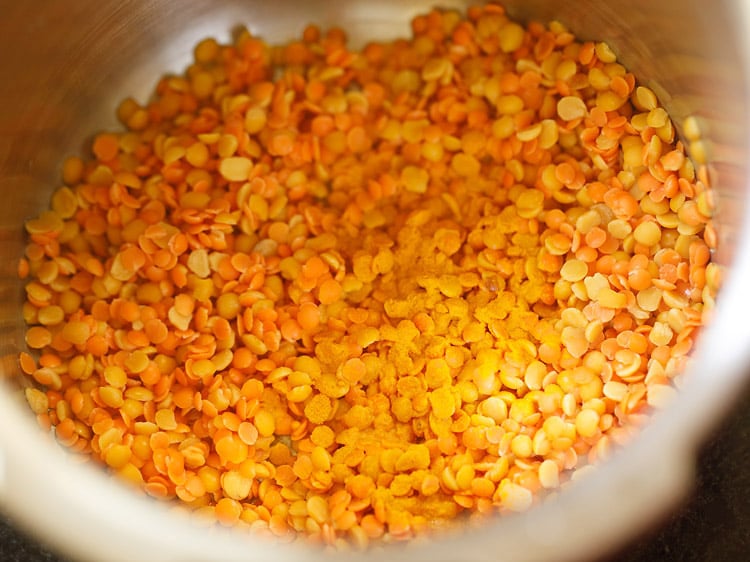
4. Pressure cook the lentils on medium heat for about 7 to 8 whistles, 11 to 12 minutes or till soft, mushy and well cooked.
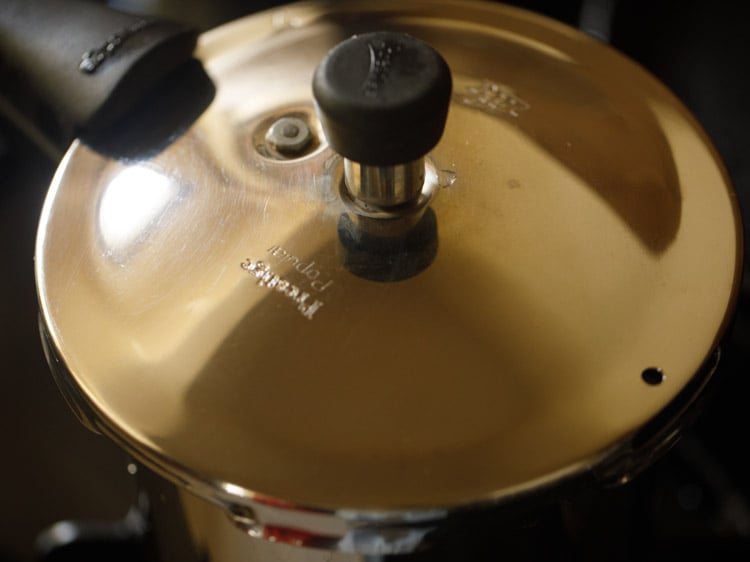
5. Open the lid once the pressure settles down naturally in the cooker. The lentils should have softened very well, so that they can be easily mashed.
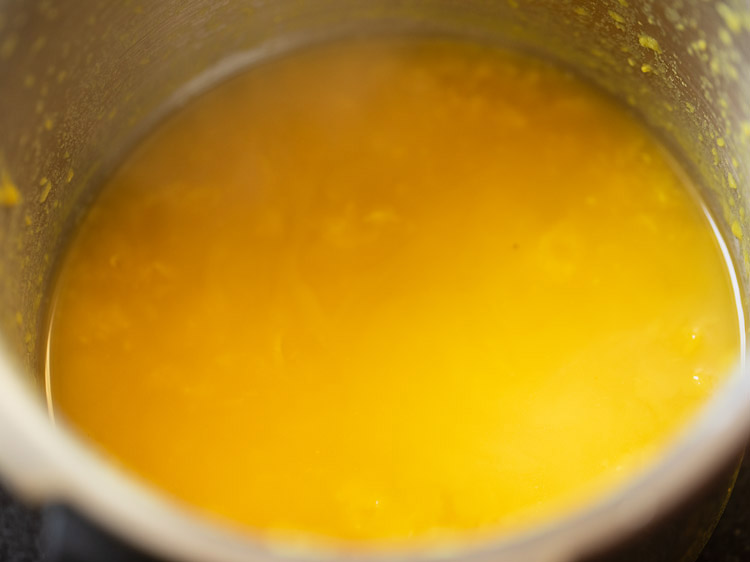
6. Mash the lentils with a spoon or wired whisk. Set cooked lentils aside.
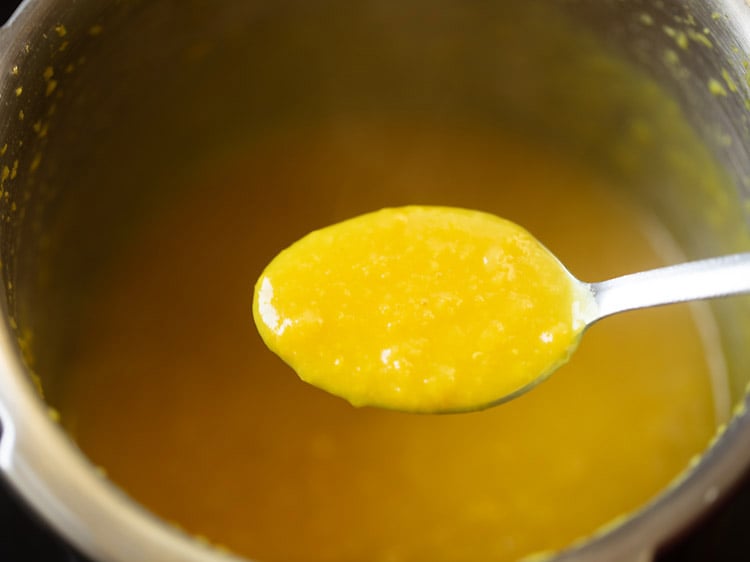
Make Tamarind Pulp
7. Take 1 tablespoon tamarind and soak it in ¼ to ⅓ hot or warm water for 20 to 30 minutes.
Tip: If you don’t have dried tamarind, then you can use about ½ tablespoon packaged tamarind paste or as needed.
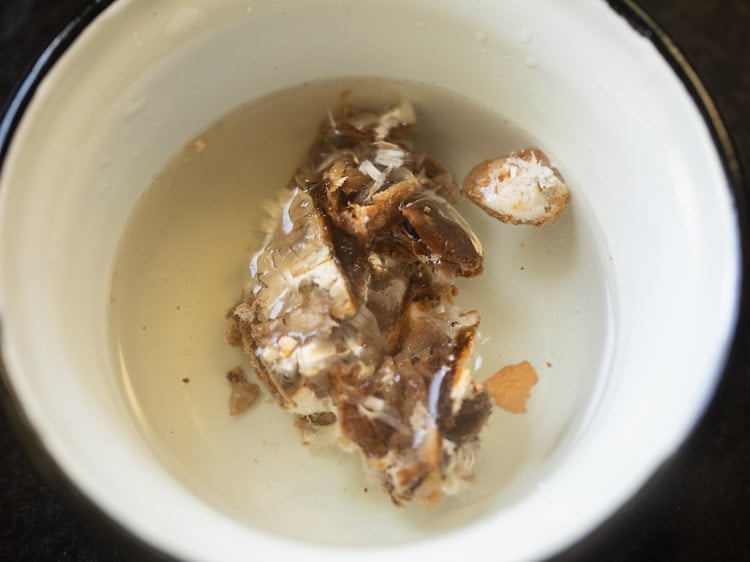
8. Later, squeeze the tamarind in the water and you get the tamarind pulp. You can even strain tamarind pulp and keep it aside.
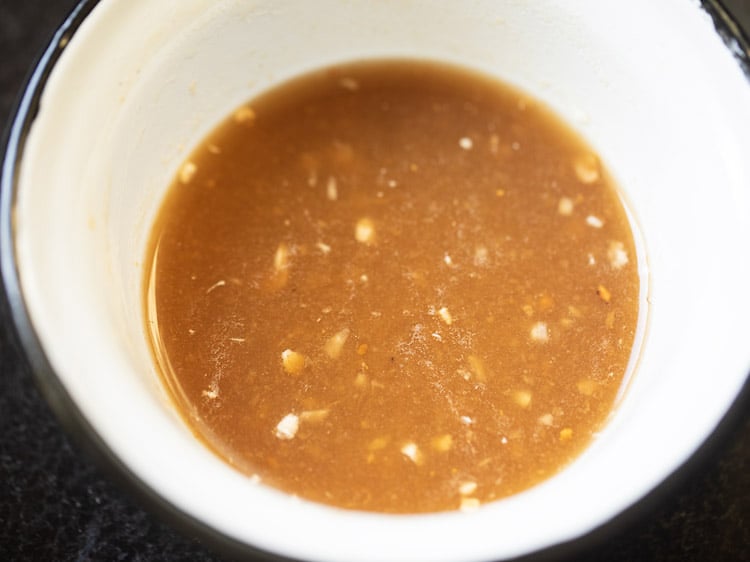
Roast Ingredients For Tiffin Sambar Mix
9. In a heavy small frying pan, heat 2 teaspoons oil. Keep the heat to its lowest. First, add ½ teaspoon mustard seeds. Mix and stir.
You can use any neutral flavored oil.
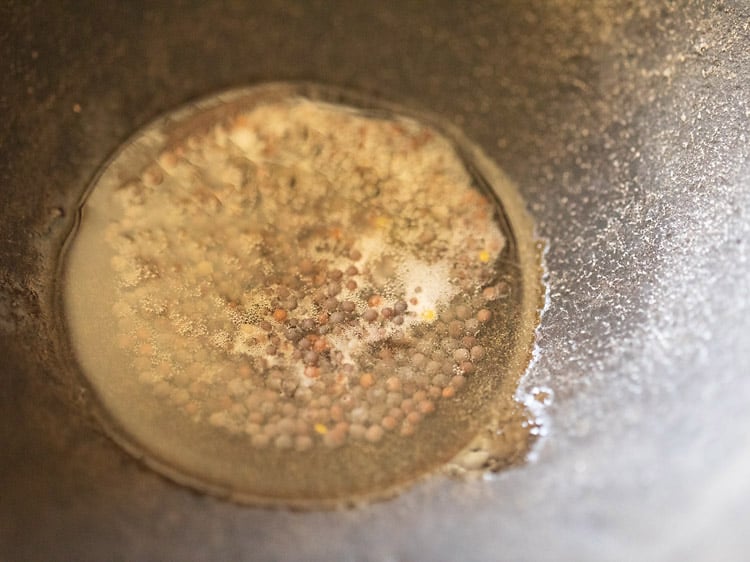
10. Then, add the following ingredients:
- 1.5 tablespoons coriander seeds
- ¼ teaspoon fenugreek seeds
- 1 teaspoon cumin seeds
- ½ teaspoon black peppercorns
- 1 tablespoon chana dal (husked and split Bengal gram)
Mix and stir.
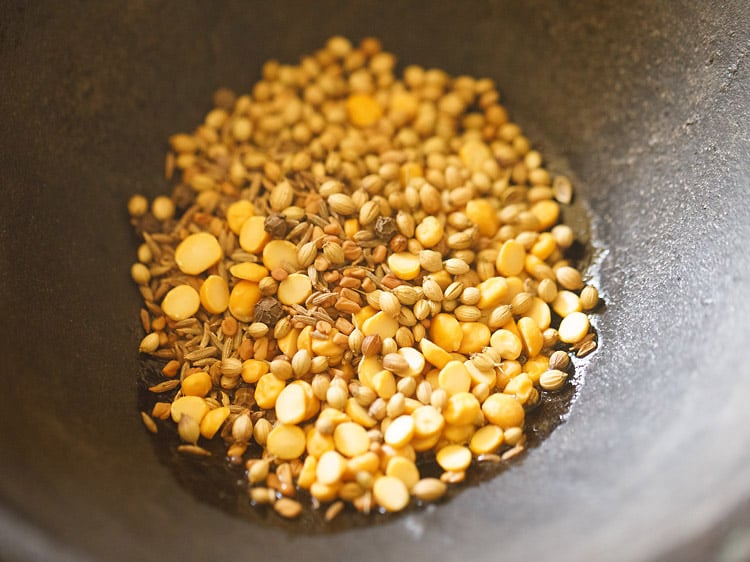
11. Immediately, add 5 Kashmiri dried red chilies or 5 byadagi chilies (broken and seeds removed).
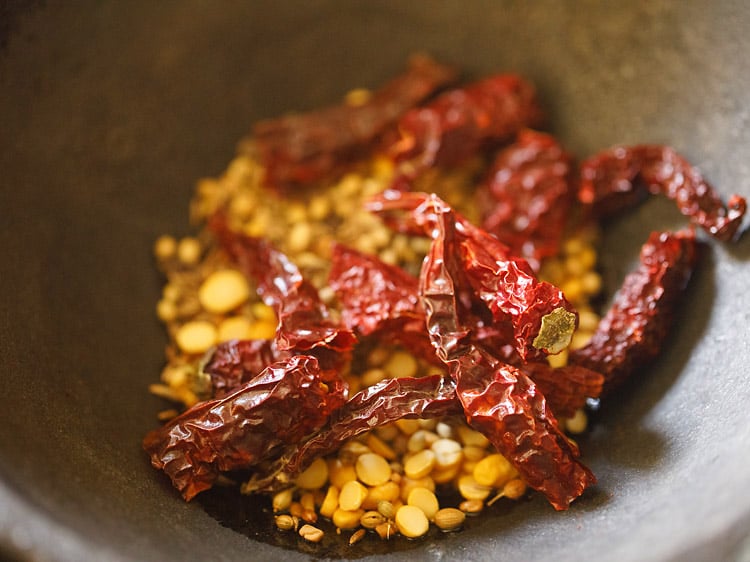
12. Next, add 11 to 12 curry leaves.
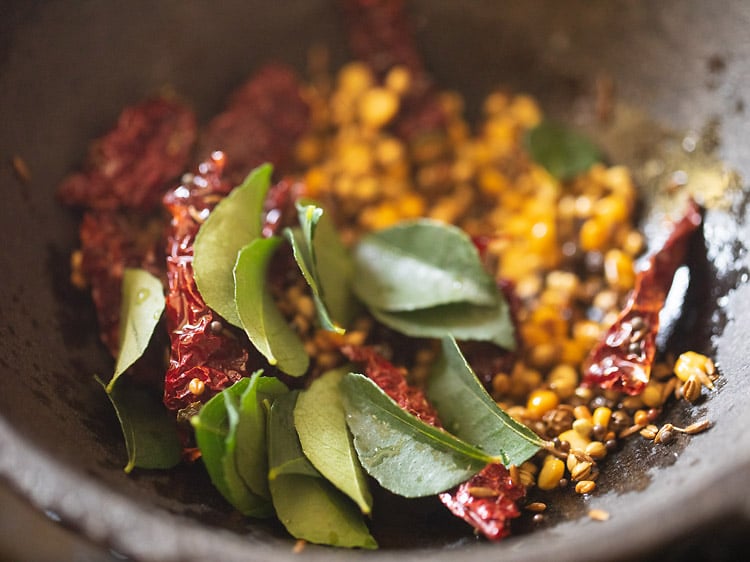
13. Mix very well. On low heat, stir continuously and roast till the spices and lentils become aromatic. Ensure not to burn the spices.
Once the spices are roasted well, you can also add 2 to 3 tablespoons fresh coconut or desiccated coconut. Mix the coconut and roast for 1 to 2 minutes and turn off the heat.
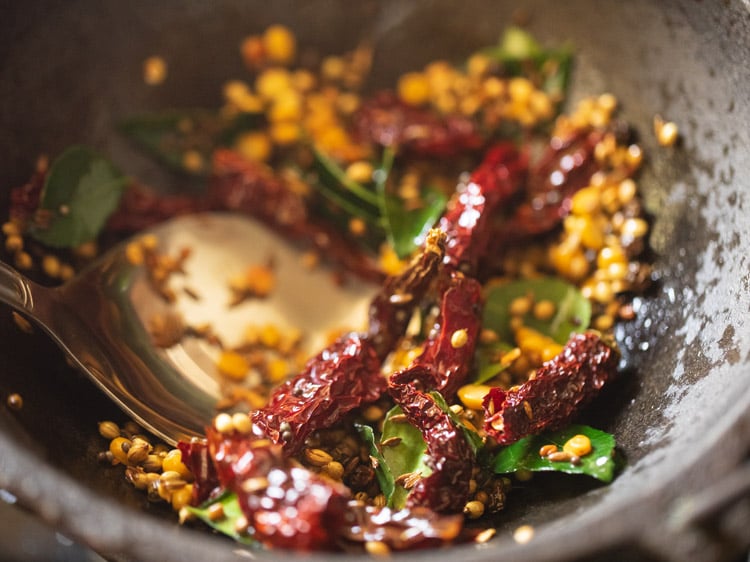
14. Set the roasted spices and lentils aside to cool.
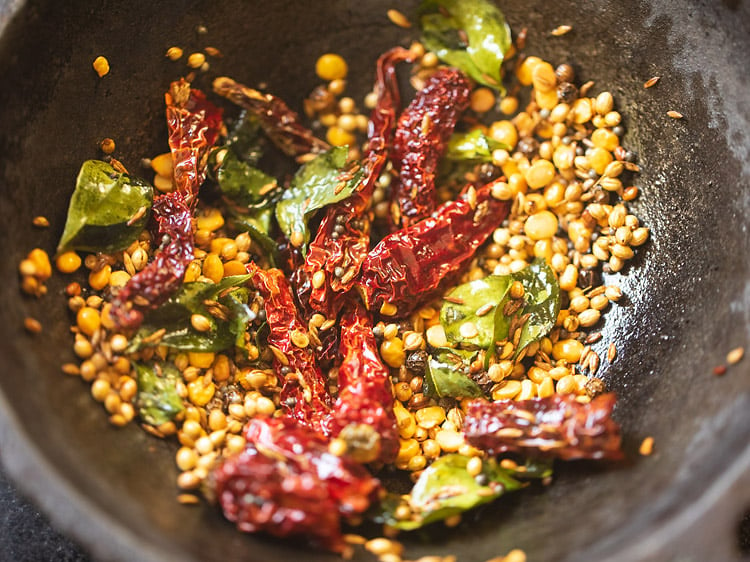
Make Tiffin Sambar Powder
15. Once the spices cool, grind to a fine powder in a dry grinder or coffee grinder.
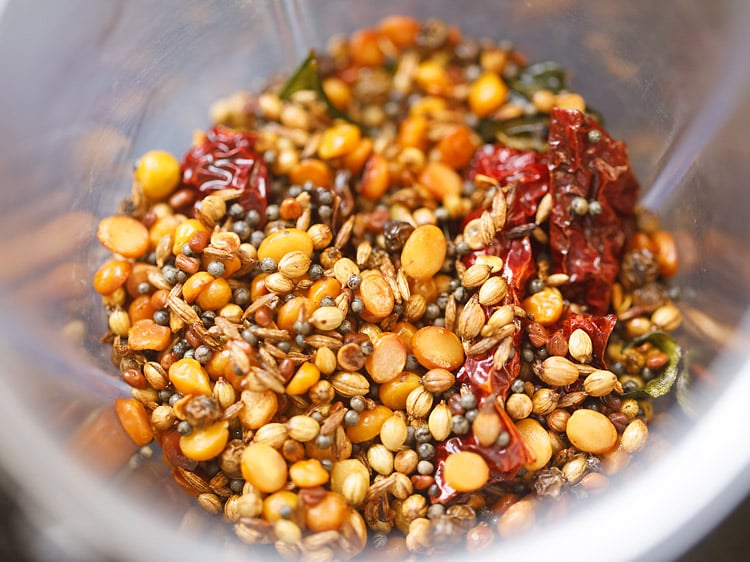
16. Keep the Tiffin Sambar powder aside.
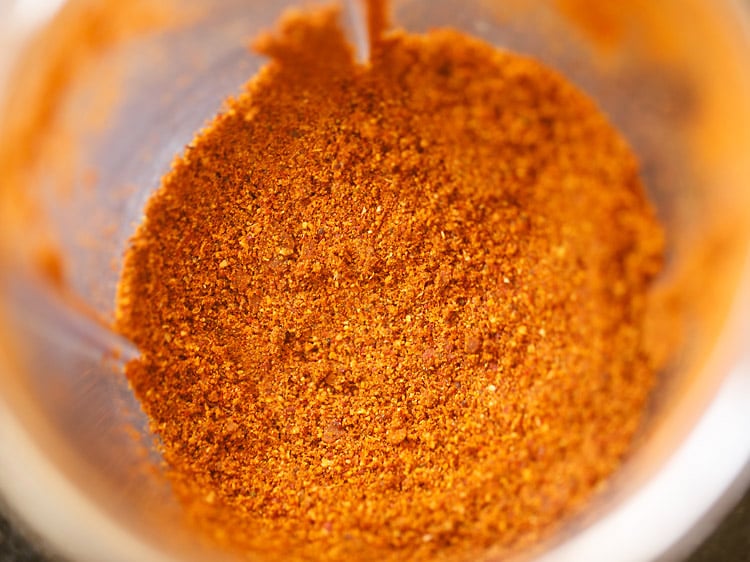
Prep Vegetables
17. Rinse and peel vegetables. Chop them and set aside.
You can use a mix of drumsticks, carrots, pearl onions, yellow pumpkin, radish, green beans, ash gourd, potatoes, small brinjals (baby eggplants), okra, etc.
While cooking, just remember to add the vegetables that take more time to cook first and later add the veggies which take less time to cook.
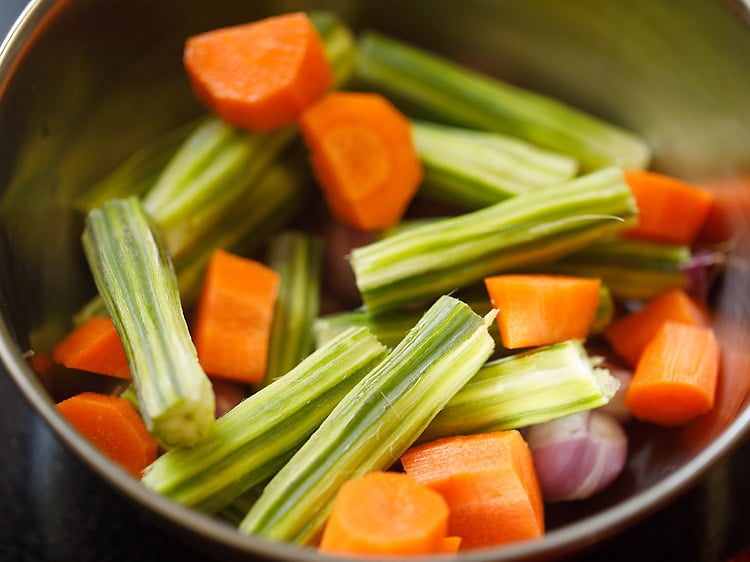
18. For brinjals, chop and add them to water so that no discoloration occurs.
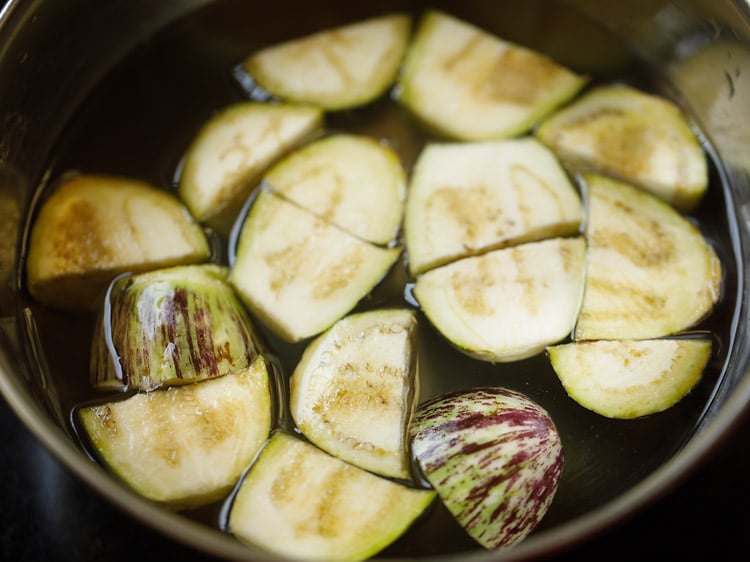
Sauté Onion & Spices
19. In a pot, heat 2 tablespoons oil first. Keep heat to low or medium-low.
Add ½ teaspoon mustard seeds and let them crackle.
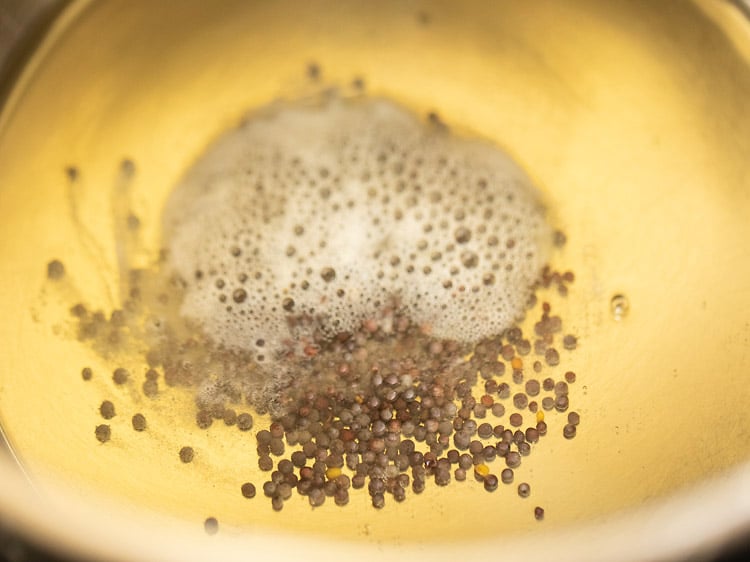
20. Next, add 1 teaspoon urad dal (husked and split black gram).
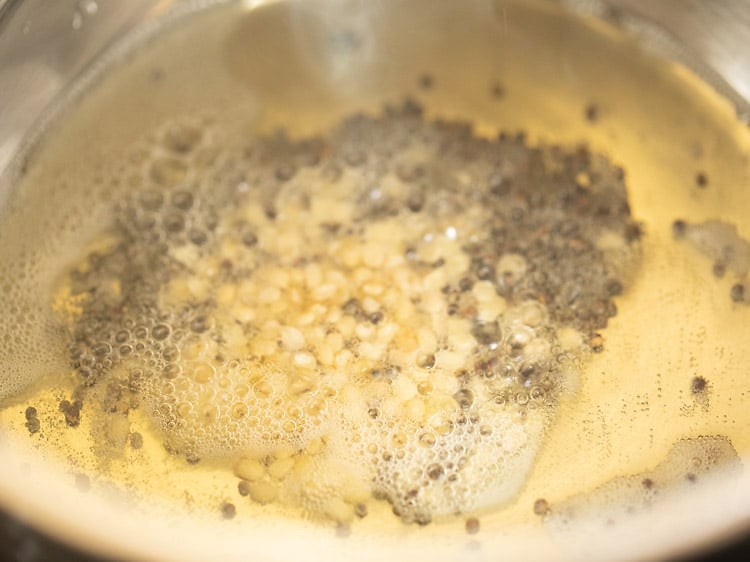
21. Let the urad dal turn into a maroonish color.
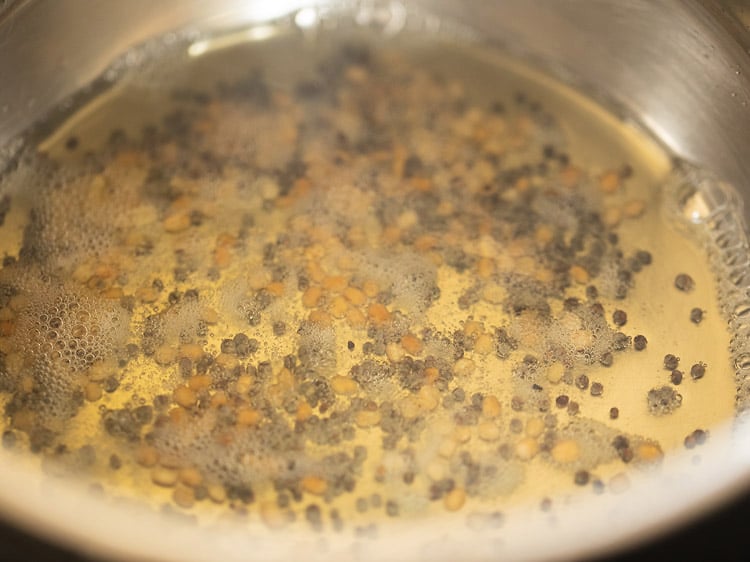
22. Next, add 1 large quartered onion or 10 to 12 pearl onions (whole or halved), 4 to 5 curry leaves and ¼ teaspoon asafoetida (hing).
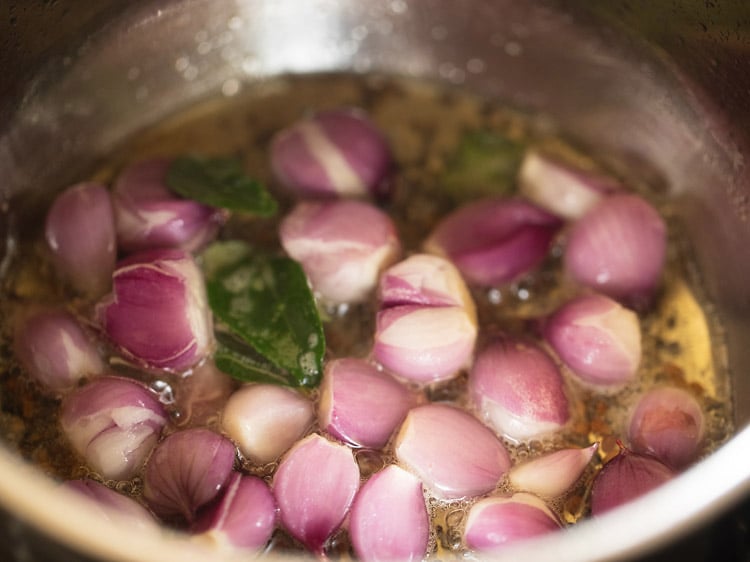
23. Stir and sauté on medium-low heat for 2 minutes.
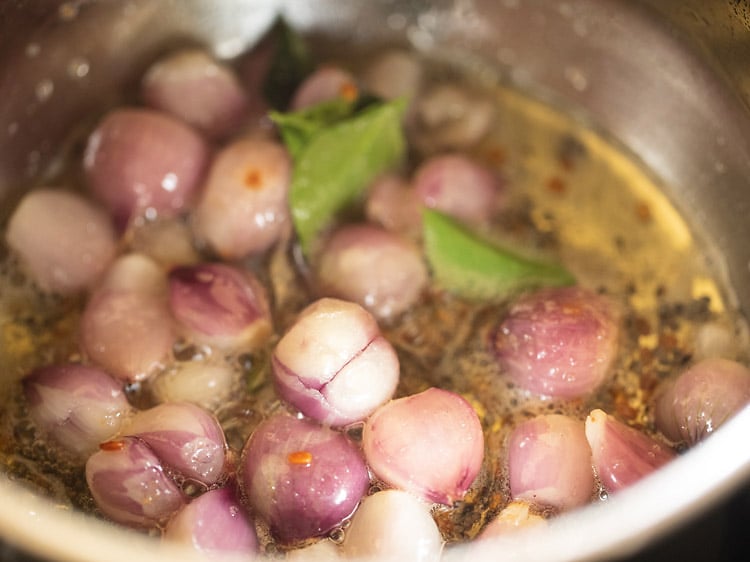
24. Sauté till the onions soften a bit.
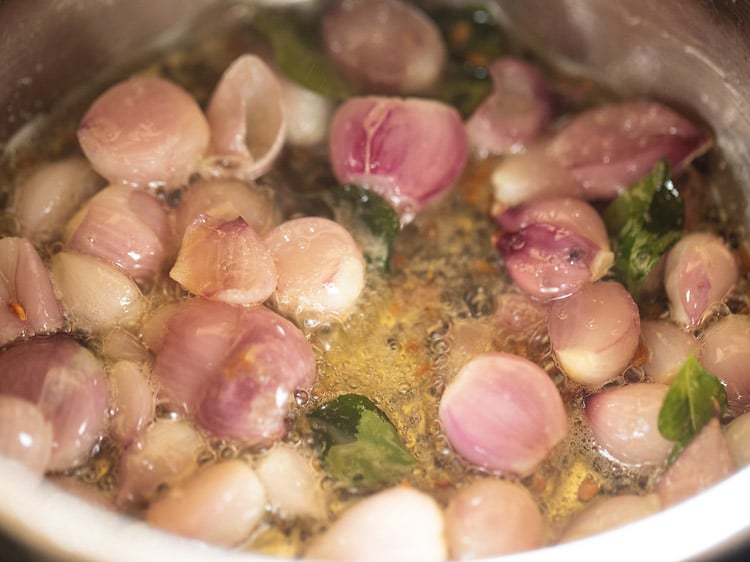
Sauté Tomatoes
25. Next, add 3 medium-sized chopped tomatoes (about 1.25 to 1.5 cups).
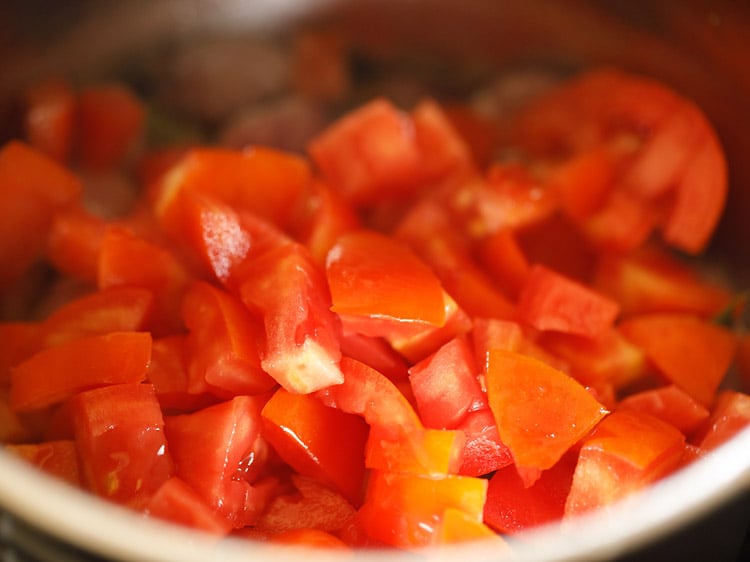
26. Sauté tomatoes on medium-low heat for 4 to 5 minutes.
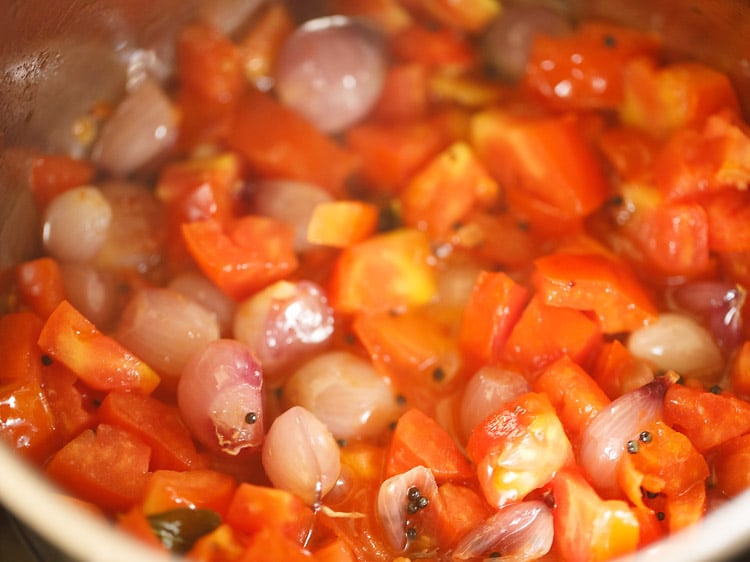
Sauté & Cook Vegetables
27. Next, add the vegetables which take more time to cook like carrots, beans, potatoes, drumsticks, etc.
I have used the following vegetables:
- 1 to 2 drumsticks – scraped and chopped in 2 to 3 inch pieces
- 1 medium carrot – chopped
- 6 to 7 green beans or flat beans – chopped
- 1 medium potato – chopped, optional
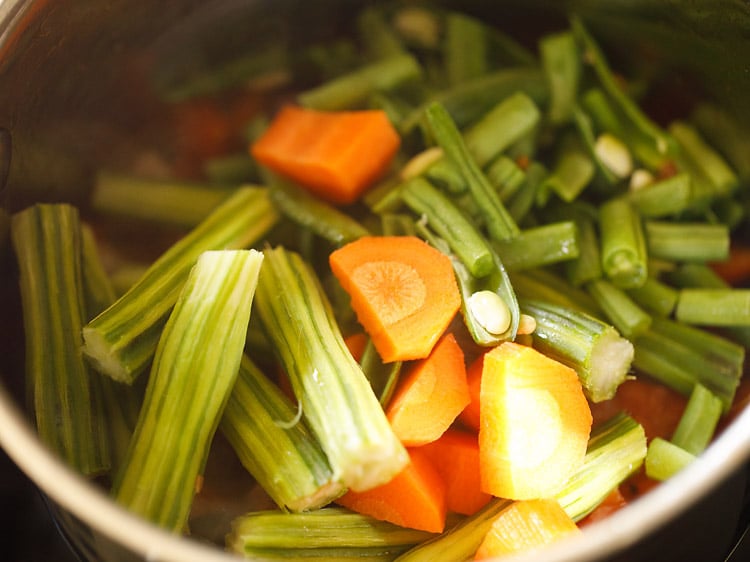
28. Sauté on medium heat, stirring often, for 4 to 5 minutes.
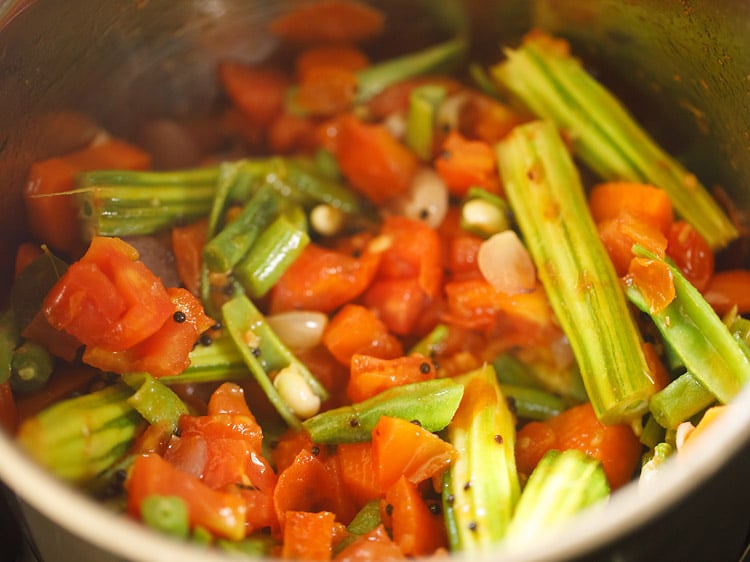
29. Then, add the remaining quick-cooking vegetables like small brinjals, ladyfingers (okra), pumpkin, etc. Mix well.
Here I have added:
- 4 to 5 okra – chopped into 1 to 1.25 inches
- 6 to 7 small brinjals (baby eggplants) – quartered or halved, 80 to 100 grams
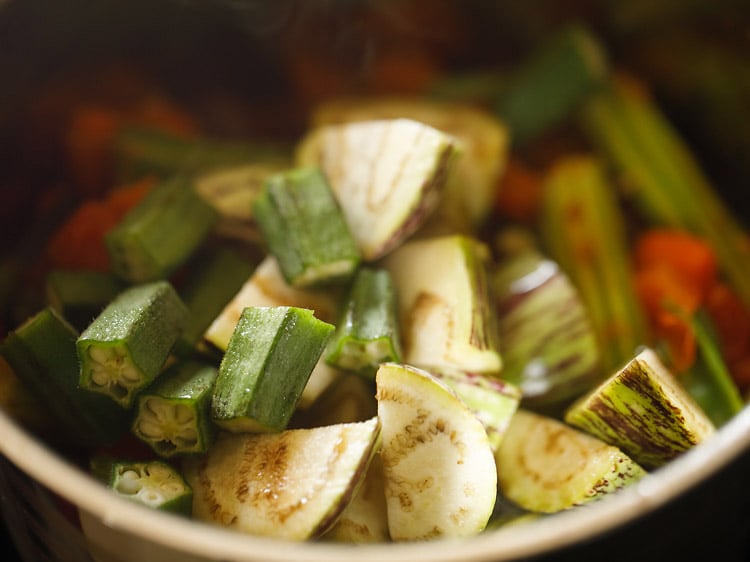
Make Idli Sambar
30. Add the prepared tamarind pulp.
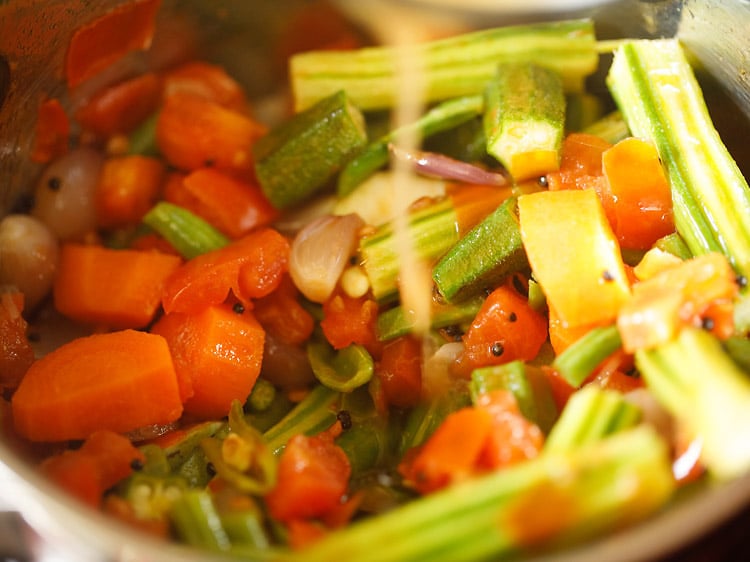
31. Add 1 to 1.25 cups of water.
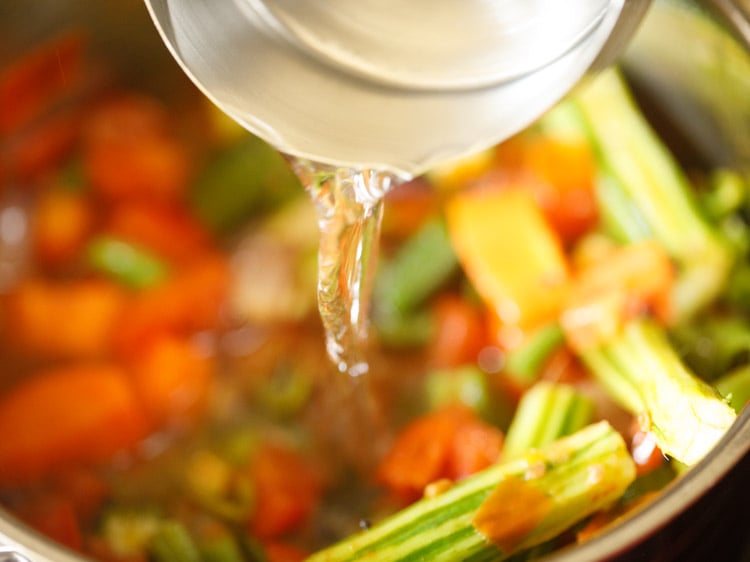
32. Add salt as per taste and mix well.
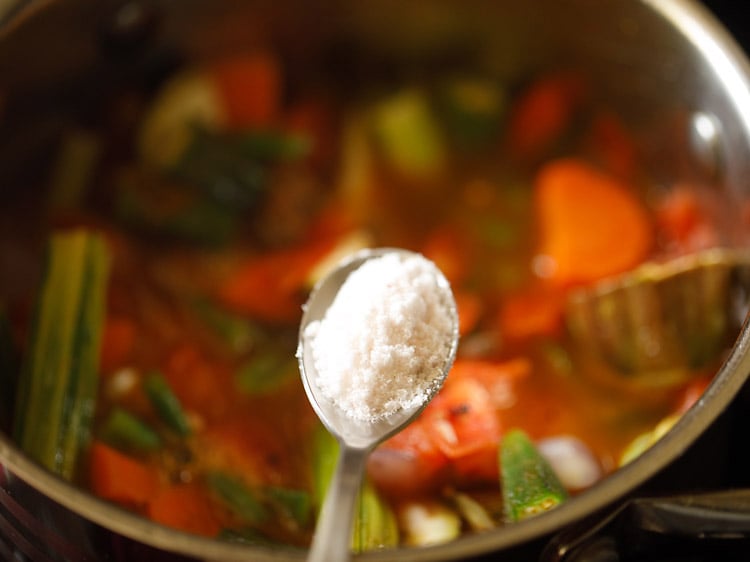
33. Cover the pan and simmer on medium-low heat until the raw aroma of the tamarind goes away and the vegetables are almost tender and cooked.
If they are undercooked, then continue to simmer until they soften.
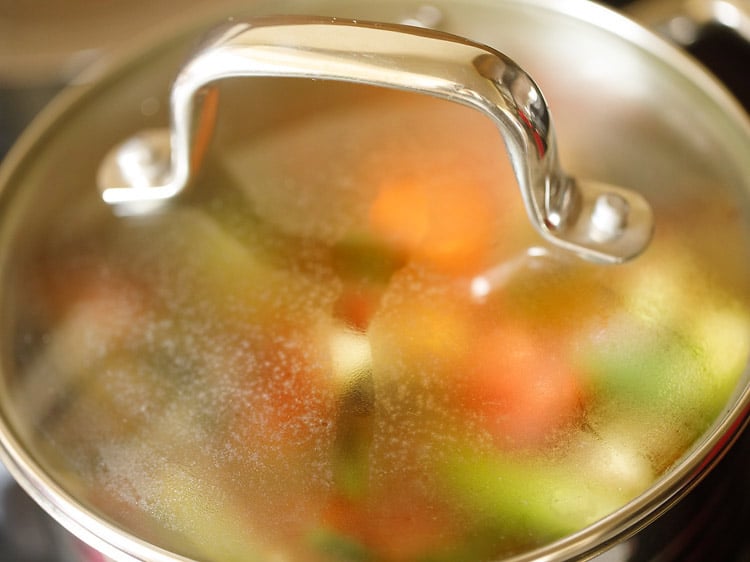
34. The vegetables should be almost cooked before you proceed to another step.
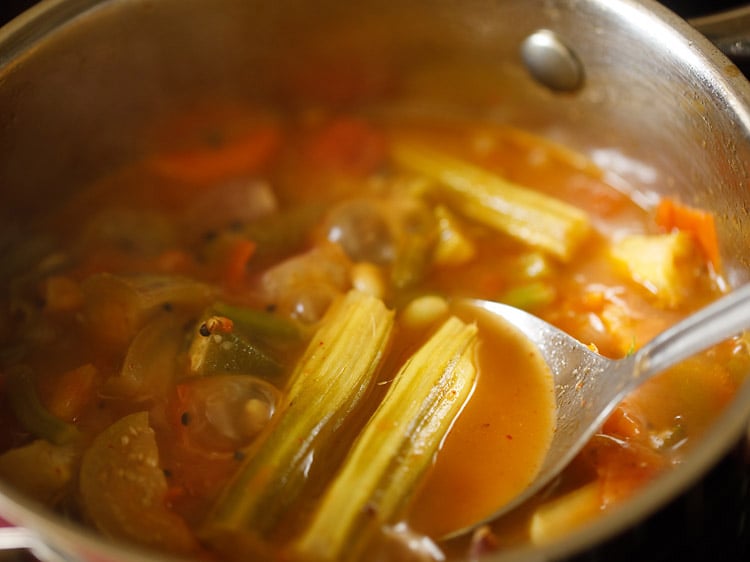
35. Add all of the prepared sambar powder.
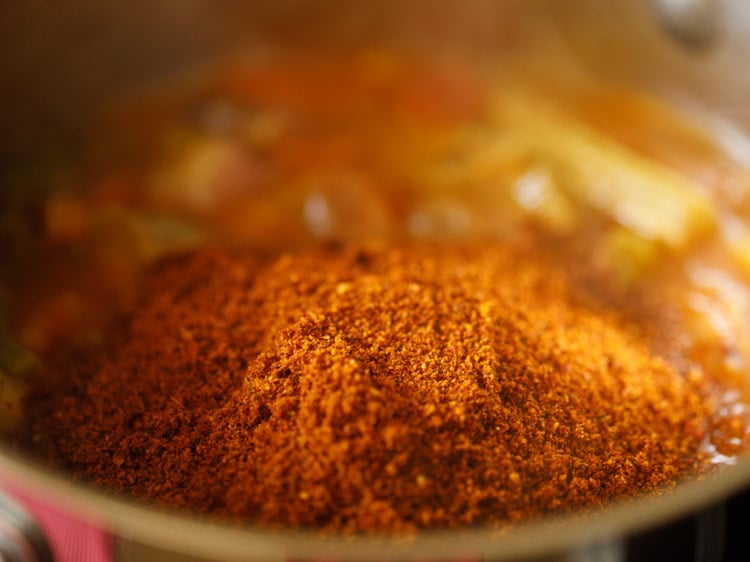
36. Mix very well.
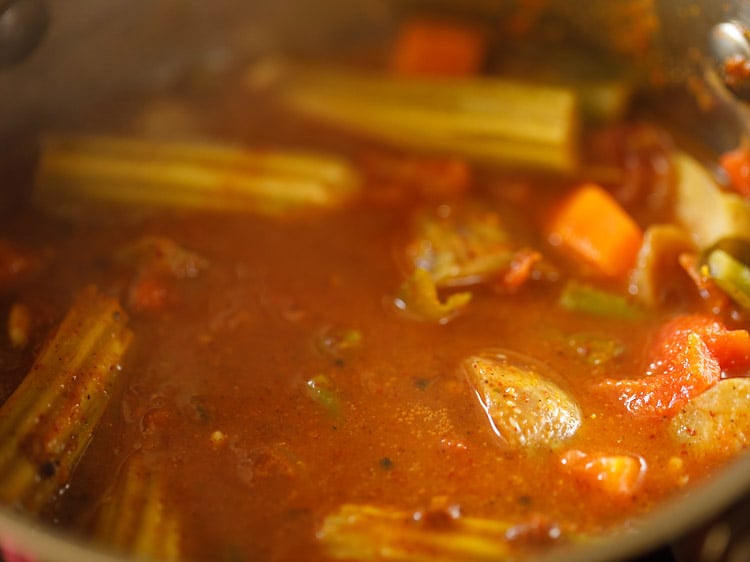
37. Add the mashed lentils.
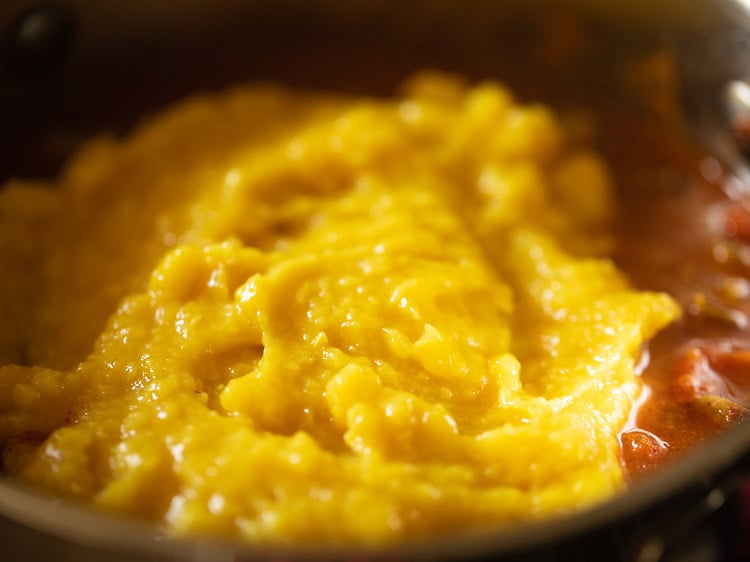
38. Mix again very well. Also, add 1 cup water or more to get the consistency you want.
The Tiffin Sambar served in the hotels is usually thinner. For serving with idli, dosa and medu vada, you can keep the sambar having a medium to thin consistency.
For serving with rice, keep the sambar slightly thick.
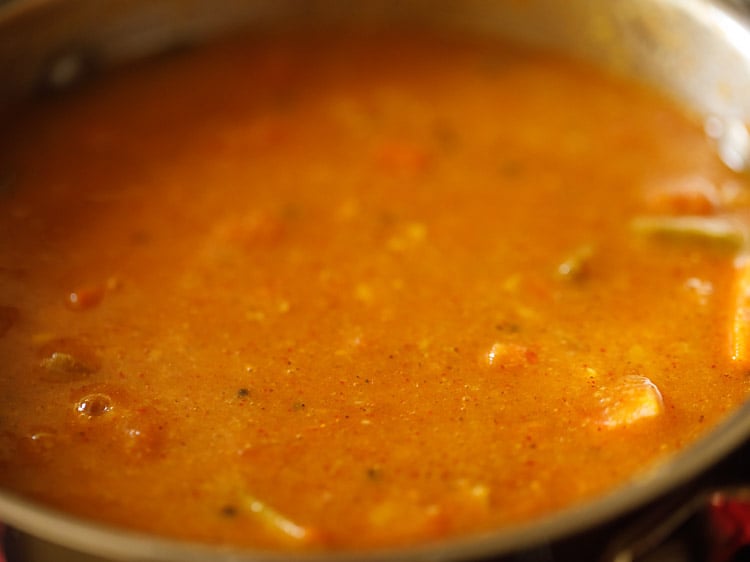
39. Stir and simmer without lid for about 6 to 7 minutes or until it comes to a boil.
Then, turn off the heat. Stir at intervals so that the lentils do not stick at the bottom of the pan.
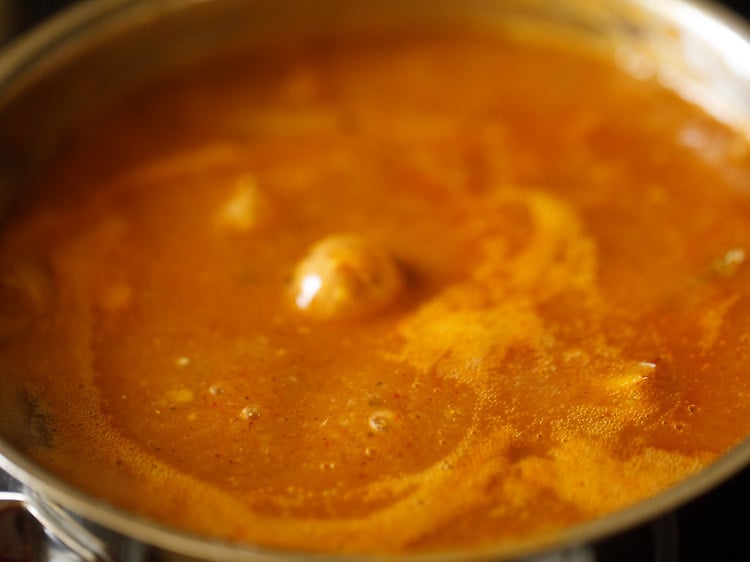
40. Meanwhile, you can steam idli. Both mini idli or large idli pairs well with this Tiffin Sambar.
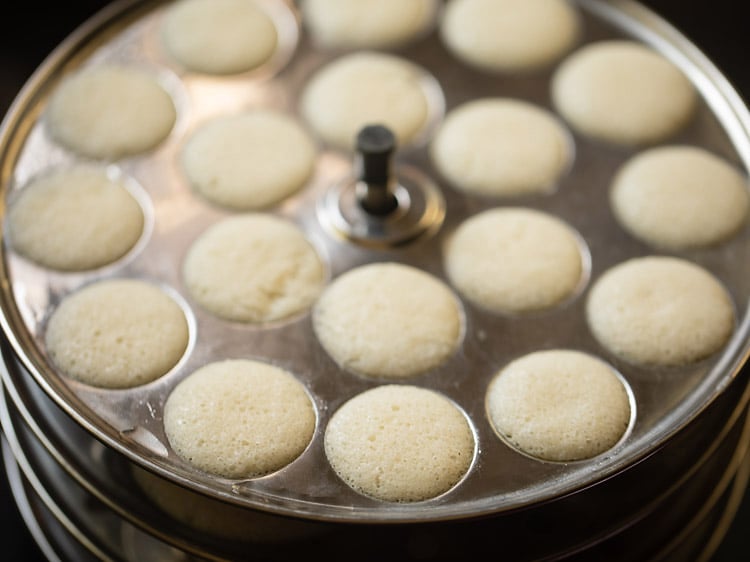
41. While serving, place the idli in a serving bowl. Pour sambar on top, garnish with some coriander leaves. You can even drizzle a bit of ghee on top and serve Idli Sambar hot.
Additionally some finely chopped onions, grated carrots or beets can be topped on the delish Idli Sambar.
This tiffin sambar can also be served hot with medu vada, uttapam or masala dosa. You can also enjoy it with steamed rice.
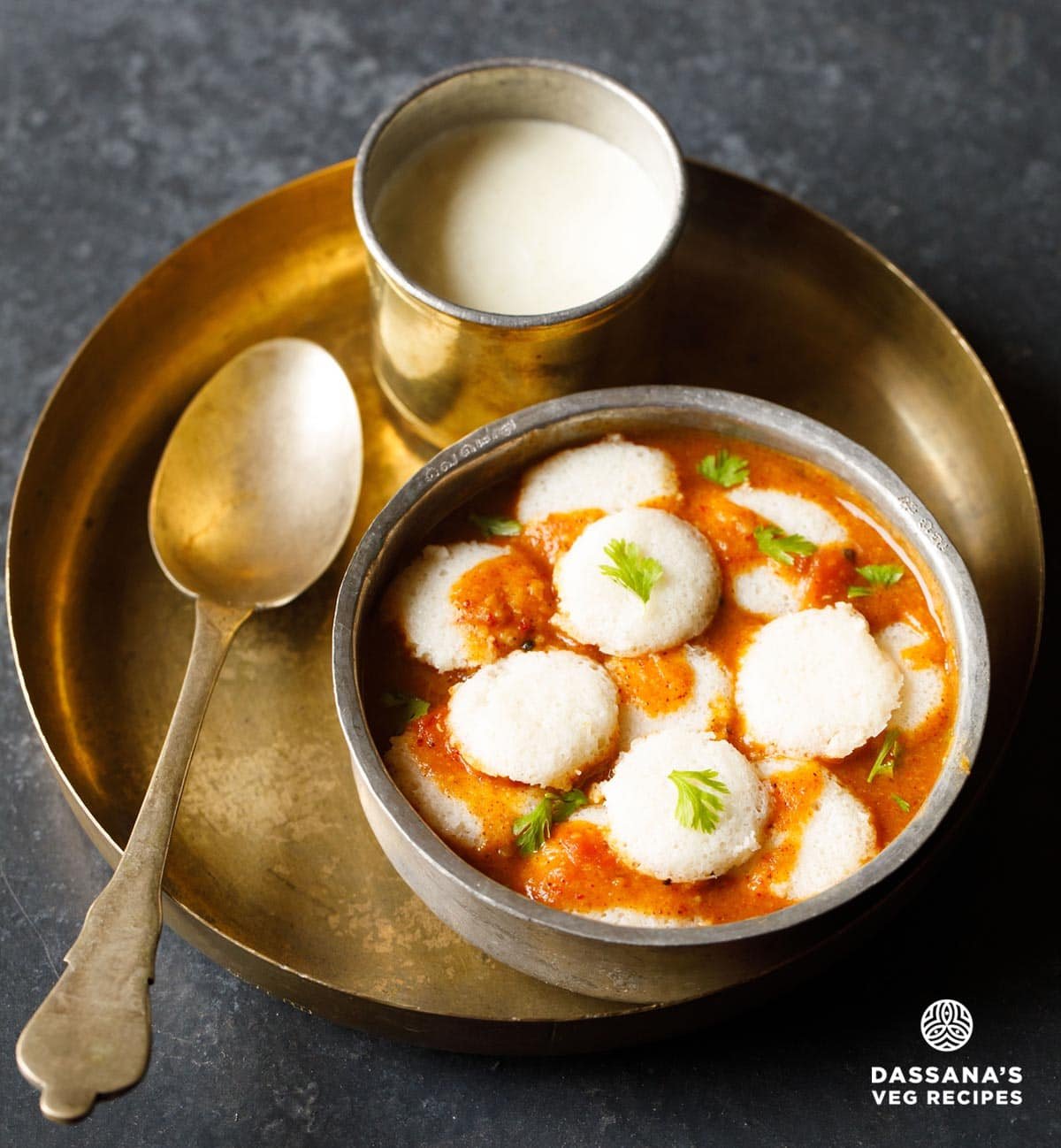
Expert Tips
- Homemade Sambar Mix: In the recipe, freshly roasted and ground sambar powder is made. This sambar powder adds a lot of flavor in the sambar. If you are short of time, then you can use any sambar powder you have and make this recipe. Note that the final taste of the sambar depends a lot on the type of sambar powder added. So, use a good quality sambar powder or use your homemade Sambar Powder.
- Roasting Spices: While roasting the spices for the sambar powder, use a heavy or a thick-bottomed pan on low heat. Stir continuously, so that the spices do not get burnt. The spices have to be roasted until they turn fragrant and golden. Use fresh spices and make sure they are not rancid.
- Vegetables To Add: Tomato is one of the key ingredients in this sambar, which adds a lot of flavor. So, do not skip it. For the vegetables, add the ones that are usually added in sambar. Do try to add drumsticks, if you can, as in most hotel style sambars, it is added. It gives a nice taste in the sambar. You can also add carrots, green beans, flat beans, ladyfingers (okra), brinjals, potatoes, pumpkin, ash gourd, onions, etc.
- Lentils: Both tuvar dal and masoor dal are added in the sambar served in hotels. If you do not have masoor dal, just add tuvar dal. You can also add some moong dal in combination with tuvar and masoor dal.
Planning & Cooking Tiffin Sambar
- Some preparations and planning in advance are required if you want to make this Tiffin Sambar with idli for breakfast. So, make the idli batter and ferment it the previous afternoon or late evening (for winters) or night (for summers).
- When the batter is fermented the next day, you can steam idli while you pressure cook the dal and cook the veggies in a pot or pan.
- I usually pressure cook lentils first. Then, roast the spices and make the sambar powder from scratch. When the lentils are cooking, I steam the idli and keep them stored in a hot pot or casserole so that they stay warm. After making the sambar powder, I cook the vegetables and then make the tiffin sambar.
- On busy mornings, you can make the sambar powder a day before and refrigerate. Next day, cook the lentils and veggies. Then, make the sambar.
- For making Idli Sambar, you can either make Mini Idli or the regular sized idli. Both taste good.
- While serving, make sure the sambar is hot. The idli can be hot or warm. If the idli have turned cold, then sprinkle some water on them and warm in a sauté pan or frying pan or a skillet, covered with a lid or in a microwave oven.
FAQs
1. Can I prepare the tiffin sambar powder in advance?
Yes, you can make the sambar powder a day ahead and refrigerate it. This helps in saving time during busy mornings. Ensure it’s stored in an airtight container to retain its freshness.
2. Is it necessary to use both tuvar dal and masoor dal?
While the combination of tur dal and masoor dal provides a unique flavor and texture, you can use only tur dal if preferred. Adjust the quantity accordingly to maintain the consistency of the sambar.
3. Can I use store-bought sambar powder instead of making it from scratch?
Yes, store-bought sambar powder can be used as a substitute. However, freshly ground sambar powder enhances the aroma, flavor and taste of the dish.
4. What vegetables are best suited for this sambar?
Commonly used vegetables include carrots, drumsticks, pumpkins, and beans. Feel free to use vegetables of your choice, keeping in mind the cooking time required for each.
5. How can I keep idli warm and soft until serving?
After steaming, place the idli in a casserole or an insulated container to retain their warmth and softness. If they cool down, sprinkle some water and reheat them in a steamer or a skillet or sauté pan covered with lid.
6. Is this sambar recipe vegan?
Yes, the recipe is vegan. However, if you choose to drizzle ghee on top while serving, it will no longer be vegan. For a vegan alternative, you can use plant-based oils.
7. Can this sambar be paired with dishes other than idli?
Absolutely. This sambar pairs well with dosa, medu vada, rava idli, rava dosa, uttapam, pongal, and even steamed rice.
More South Indian Tiffin Recipes To Try!
Breakfast Recipes
Breakfast Recipes
Breakfast Recipes
Evening Snacks
Please be sure to rate the recipe in the recipe card or leave a comment below if you have made it. For more vegetarian inspirations, Sign Up for my emails or follow me on Instagram, Youtube, Facebook, Pinterest or Twitter.
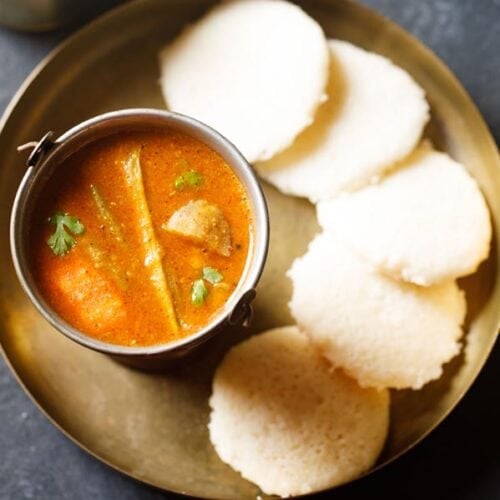
Idli Sambar Recipe | How to make Tiffin Sambar
Ingredients
For cooking lentils
- ¼ cup tur dal (husked & split tuvar dal or pigeon pea lentils)
- ¼ cup masoor dal (husked & split red lentils)
- ¼ teaspoon turmeric powder (ground turmeric)
- 1.25 to 1.5 cups water – for cooking in a 2 litre stovetop pressure cooker
For tempering
- 2 tablespoons oil – gingelly oil, sunflower oil or peanut oil
- ½ teaspoon mustard seeds
- 1 teaspoon urad dal (husked & split black lentil)
- 4 to 5 curry leaves
- ¼ teaspoon asafoetida powder (hing)
For cooking veggies
- 1 large (100 grams) onion – chopped or 10 to 12 pearl onions or small shallots
- 3 medium-sized (220 to 230 grams) tomatoes – chopped
- 1 to 2 drumsticks – scraped and chopped in 2 to 3 inch pieces
- 1 carrot – medium-sized
- 6 to 7 green beans or or flat beans, chopped
- 1 potato – medium-sized, optional
- 4 to 5 okra – chopped (bhindi)
- 6 to 7 nos or (80 to 100 grams) brinjals – small sized, (mini or baby eggplants) quartered or halved depending on the size
- 1 to 1.25 cups water or add as required
- salt as required
For tamarind pulp
- 1 tablespoon tamarind
- ¼ to ⅓ cup water – warm or hot
For tiffin sambar powder
- 5 kashmiri chilies or or byadagi/bedgi chilies or 4 to 5 dry red chilies – reduce depending upon the heat in the chilies
- 11 to 12 large curry leaves or 16 to 18 small curry leaves
- 1.5 tablespoons coriander seeds
- 1 tablespoon chana dal (split & husked bengal gram)
- 1 teaspoon cumin seeds
- ½ teaspoon mustard seeds
- ½ teaspoon whole black pepper
- ¼ teaspoon fenugreek seeds (methi dana)
- 2 teaspoons oil – gingelly oil, sunflower oil or peanut oil
Other ingredients
- 1 cup water – to be added later or add as required
- 1 to 2 tablespoons coriander leaves – chopped for garnish
Instructions
Cooking the lentils
- Rinse both the lentils well and then add them in a 2 litre stovetop pressure cooker with 1.25 to 1.5 cups water and ¼ teaspoon turmeric powder.
- Pressure cook the lentils for 7 to 8 whistles or 11 to 12 minutes until the lentils have softened and well cooked.
- You can also cook the lentils in a pan on a stove top or in the instant pot. I recommend to soak the lentils for about 30 minutes in enough water prior to cooking them in a pan. This helps in the faster cooking of the lentils.
- Once the pressure settles down naturally in the cooker, open the cooker. Mash the lentils with a wired whisk and spoon. Keep aside.
Making tiffin sambar powder
- In a small and heavy frying pan, heat 2 teaspoons oil. Keep the heat to a low. First, add the mustard seeds.
- Then add the coriander seeds, cumin seeds, black pepper, chana dal (bengal gram), fenugreek seeds, curry leaves and dry red chillies.
- On a low heat stir non-stop and roast till the spices become aromatic and golden.
- Keep aside to cool. Don’t burn the spices.
- Once the spices cool, grind them to a powder in a dry grinder or coffee grinder. Keep aside.
Preparation for idli sambar
- Soak the tamarind in warm water for 25 to 30 mins.
- Later squeeze the tamarind in the soaked water and extract the tamarind pulp. You can strain tamarind pulp and keep aside.
- Chop all the veggies. Quarter the onions or halve the pearl onions. Peel and dice the carrots and potatoes.
- Dice the brinjals and add them in water to prevent discoloration.
- Chop the tomatoes in small pieces.
Cooking veggies
- In a pan, heat oil first. Add the mustard seeds and let them begin to crackle. Then add the urad dal and sauté till they turn to a maroonish color.
- Add quartered onions or halved pearl onions, curry leaves and asafoetida. Stir and saute for 2 minutes till the onions soften a bit.
- Add the tomatoes, salt as required and continue to saute for 4 to 5 minutes on a medium-low heat.
- Then add the veggies which take a longer time to cook (carrots, beans, potatoes, drumsticks etc) and saute for 4 to 5 minutes on a medium-low flame.
- Then add remaining quick-cooking veggies like brinjals, ladyfingers (okra), pumpkin etc now. Stir and mix.
- Add the tamarind pulp and 1 to 1.25 cups water.
- Season with salt as per taste. Mix well.
- Cover pan and simmer until the raw aroma of the tamarind goes away and the veggies are almost cooked.
- If the veggies are undercooked, then continue to simmer till they are almost cooked.
Making idli sambar
- Add the ground sambar powder which we have already prepared. Mix well.
- Add the mashed dal.
- Add 1 cup water or as required depending on the consistency you want.
- Stir and simmer without lid for about 6 to 7 minutes or till it comes to a boil. Stir at intervals.
- Check the taste and add more salt if required.
- Meanwhile when you keep the dal for pressure cooking, you can steam idli. Both small-sized mini idli or large idli goes well with tiffin sambar.
- While serving place the idli in a serving bowl. Pour sambar. Garnish with some coriander leaves. You can even drizzle a bit of ghee on top. Serve idli sambar hot.
- You can also garnish with coriander leaves and serve hot with medu vada, idli, dosa, uttapam or even with steamed rice.
Video
Notes
- You can use vegetables of your choice like carrots, pumpkin, drumsticks, or beans.
- Along with tuvar dal, you can add masoor dal as I have done or even moong dal for variation. You could also choose to make the recipe only with tur dal.
- For best flavor, aroma and taste use freshly ground sambar powder.
- Adjust the consistency as needed — hotel-style sambar served with idli, dosa, or vada is thin, while for rice, keep the sambar slightly thick.
- The recipe can easily be halved or doubled.
- Please note that the nutrition information provided is for the tiffin sambar only, excluding the idli.
Nutrition Info (Approximate Values)
Idli Sambar recipe from the blog archives was first published on May 2014.
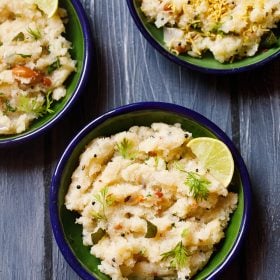
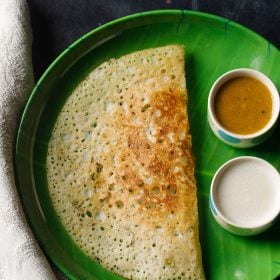
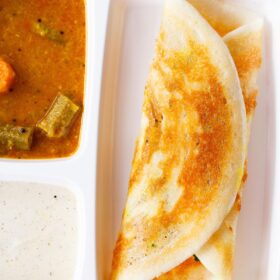
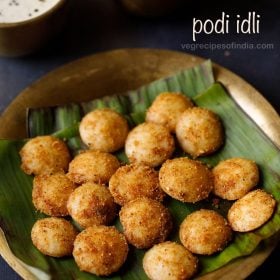
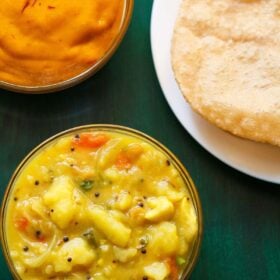
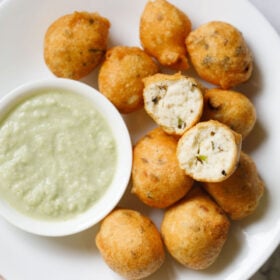
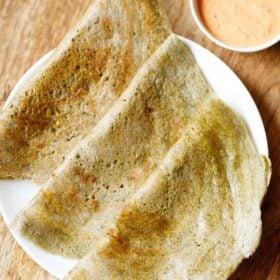
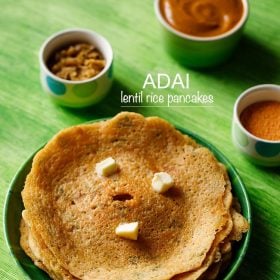









How much sambar powder do you use if using store bought powder?
For a sambar recipe which makes for 4 to 5 servings, you could add 1 to 1.5 tablespoon of the store brought powder. The quantity depends on the potency, flavors and freshness of the powder. So try experimenting with less or more and you will get a knack to add the right amount.
I’m a huge fan of idli, so i’m very happy I founf this recipe. Thank you so much!
one of my favorites 🤩 thank you, Dassana
It is good recipe by Dassana Amit
thanks.
Hello Dear,
I was thinking to write from long time… but finally I decided that I will write today..
One of the top The Best site I ever come across till now…
This sambar is so tasty that one of my frnd is using this recipe in their restaurant…
I just follow your recipe and it will be hit…. thanks a lot….
And most good thing in your site is your response for every comment… helps me to know how exactly will it be…..
I cant praise you enough…. thanks alot again….
Regards,
Shreya.
thank you shreya for such a lovely and encouraging comment. it feels good when i get to read comment like yours and does encourage me to share better recipes. thanks again.
Hi
I prepared sambar…. It’s too good… Thank you for the recipe….. Can we prepare and keep masala powder in large quantities like 250gms……. In that case… How to prepare… Is there any taste difference?
thank you nalina for this feedback on sambar recipe. of course you can make the masala, but keep in fridge. just double or triple the proportions to make sambar masala. taste will be same. prepare sambar the same way as you have made this one. any query you can ask me.
Hi Amit..recently I tried your veg cutlets it turned good and yum off course as always … Am going to try this today evening… I wana knw u mentioned to pour some water in step 14 but how much to pour a cup or more than that.. And u suggested not to use onions if fasting ?? .. Thank you plzz reply soon
thanks fazila for the feedback on veg cutlet. for adding water in the sambar, i have mentioned the amount in the ingredient list. its 1 cup water to be added later once you add the dal. you can add less or more water as per the consistency you want. onions can be skipped if fasting as per the hindu customs. so it becomes a no onion no garlic satvik sambar.
Great recipe. Excellent explanation and wonderful guidance for newbies like me. Turned out amazing. No more $15 dosage trips. Thanks n cheers mate.
Thanks Vik for your positive feedback. Glad to know that you like the sambar recipe presentation.
Thank you Dassana for your wonderful recipes. I tried the sambhar today it came out really well.I am just following your blog for almost all the recipes.
thank you sumalatha. i am glad that the idli sambar recipe turned out very well. thanks for sharing your feedback. happy cooking.
thanks for this perfect recipe. i wont be going to a south indian restaurant for idlli sambhar any more
Welcome Kirti
Can you tell me what type of tamarind you use? Here in North America, in my local grocery stores, I can find the following: tamarind concentrate (the blackish brown shiny pulp), tamarind in the brown shell (looks like a large worm with a crispy black shell, with stringy material and large seeds inside), tamarind paste (comes in a rectangle tray, the tamarind is compressed into a large 1 inch thick rectangle which can then be easily torn into pieces).
When you ask for a tablespoon of tamarind, what type is it? I have been using the paste, which I soak in boiling water in a bowl and strain out stringy fibrous material and some peels, not too many seeds. It seems to work well. Would you be able to send a photo of what the tamarind looks like when you buy it in the store? Apart from that, all other ingredients are available locally.
I love your recipes!!!!
Thanks Anita. It is tamarind which is dried. its not a pulp or paste. it is this tamarind which is shown in step by step photos also – https://www.vegrecipesofindia.com/wp-content/uploads/2014/05/hotel-style-tiffin-sambar-recipe5.jpg
Hello I tried this recipe and oh gosh it was finger licking good. You are just amazing. More talented than any other chef i guess. Lots of love.
Thanks Deeksha for your kind words. Glad to know that you liked the sambar recipe.
Hi Dassana,
Can I make this sambar using just toor dal?
archana, of course. its not compulsory to add both dals.
Dear Dassana,
Tried dis recipe,it ws yummilicious..Ur food blog hs made my life so simple.i hv tried so many of ur recipes n all turned out so tasty n almost perfect. Nw my husband says tht v dnt hv d need to go any restaurant ☺️.Thank u so much
thats a lovely feedback from you tomcy. thanks a lot. this tiffin sambar is also a favorite at home.
It came out wonderful-kids loved it! Also used lauki in addition to brinjal!
thats nice. thanks for the feedback.
Thank you for such a detailed recipe. Can we replace brinjal with other vegetables?
you can skip brinjal if you do not have them. or else you can also add lauki (bottle gourd), pumpkin, drumsticks.